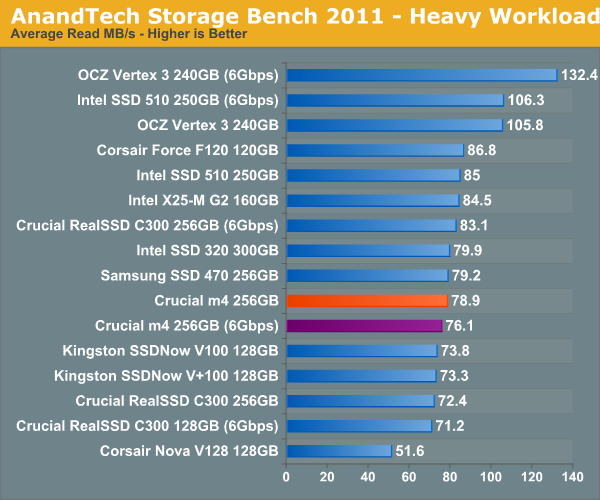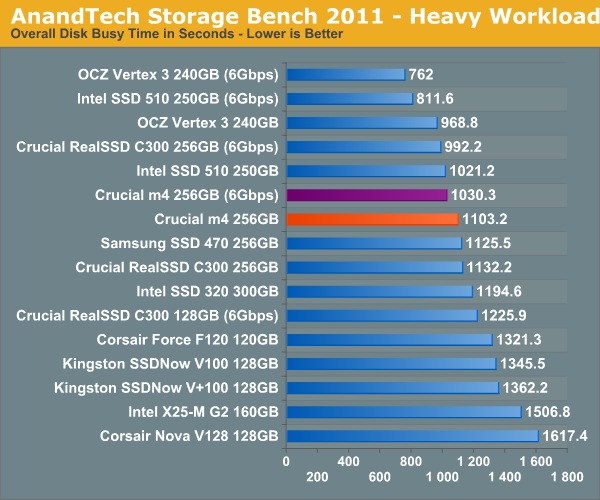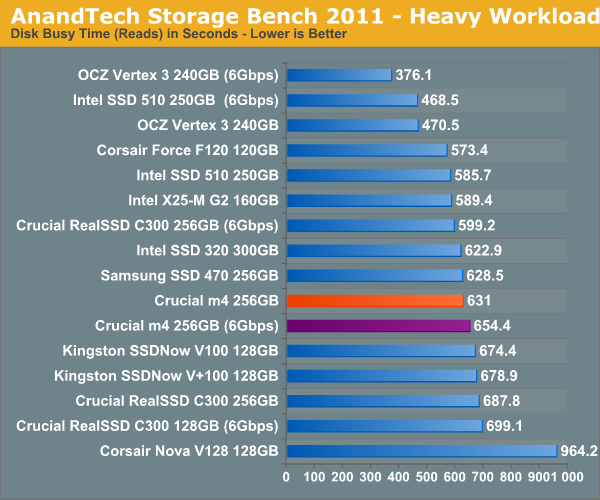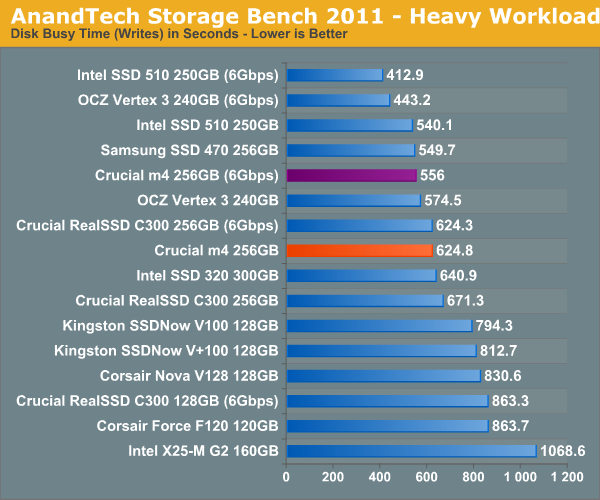The Crucial m4 (Micron C400) SSD Review
by Anand Lal Shimpi on March 31, 2011 3:16 AM ESTAnandTech Storage Bench 2011: Much Heavier
I didn't expect to have to debut this so soon, but I've been working on updated benchmarks for 2011. Last year we introduced our AnandTech Storage Bench, a suite of benchmarks that took traces of real OS/application usage and played them back in a repeatable manner. I assembled the traces myself out of frustration with the majority of what we have today in terms of SSD benchmarks.
Although the AnandTech Storage Bench tests did a good job of characterizing SSD performance, they weren't stressful enough. All of the tests performed less than 10GB of reads/writes and typically involved only 4GB of writes specifically. That's not even enough exceed the spare area on most SSDs. Most canned SSD benchmarks don't even come close to writing a single gigabyte of data, but that doesn't mean that simply writing 4GB is acceptable.
Originally I kept the benchmarks short enough that they wouldn't be a burden to run (~30 minutes) but long enough that they were representative of what a power user might do with their system.
Not too long ago I tweeted that I had created what I referred to as the Mother of All SSD Benchmarks (MOASB). Rather than only writing 4GB of data to the drive, this benchmark writes 106.32GB. It's the load you'd put on a drive after nearly two weeks of constant usage. And it takes a *long* time to run.
I'll be sharing the full details of the benchmark in some upcoming SSD articles but here are some details:
1) The MOASB, officially called AnandTech Storage Bench 2011—Heavy Workload, mainly focuses on the times when your I/O activity is the highest. There is a lot of downloading and application installing that happens during the course of this test. My thinking was that it's during application installs, file copies, downloading and multitasking with all of this that you can really notice performance differences between drives.
2) I tried to cover as many bases as possible with the software I incorporated into this test. There's a lot of photo editing in Photoshop, HTML editing in Dreamweaver, web browsing, game playing/level loading (Starcraft II & WoW are both a part of the test) as well as general use stuff (application installing, virus scanning). I included a large amount of email downloading, document creation and editing as well. To top it all off I even use Visual Studio 2008 to build Chromium during the test.
Update: As promised, some more details about our Heavy Workload for 2011.
The test has 2,168,893 read operations and 1,783,447 write operations. The IO breakdown is as follows:
| AnandTech Storage Bench 2011—Heavy Workload IO Breakdown | ||||
| IO Size | % of Total | |||
| 4KB | 28% | |||
| 16KB | 10% | |||
| 32KB | 10% | |||
| 64KB | 4% | |||
Only 42% of all operations are sequential, the rest range from pseudo to fully random (with most falling in the pseudo-random category). Average queue depth is 4.625 IOs, with 59% of operations taking place in an IO queue of 1.
Many of you have asked for a better way to really characterize performance. Simply looking at IOPS doesn't really say much. As a result I'm going to be presenting Storage Bench 2011 data in a slightly different way. We'll have performance represented as Average MB/s, with higher numbers being better. At the same time I'll be reporting how long the SSD was busy while running this test. These disk busy graphs will show you exactly how much time was shaved off by using a faster drive vs. a slower one during the course of this test. Finally, I will also break out performance into reads, writes and combined. The reason I do this is to help balance out the fact that this test is unusually write intensive, which can often hide the benefits of a drive with good read performance.
There's also a new light workload for 2011. This is a far more reasonable, typical every day use case benchmark. Lots of web browsing, photo editing (but with a greater focus on photo consumption), video playback as well as some application installs and gaming. This test isn't nearly as write intensive as the MOASB but it's still multiple times more write intensive than what we were running last year.
As always I don't believe that these two benchmarks alone are enough to characterize the performance of a drive, but hopefully along with the rest of our tests they will help provide a better idea.
The testbed for Storage Bench 2011 has changed as well. We're now using a Sandy Bridge platform with full 6Gbps support for these tests. All of the older tests are still run on our X58 platform.
AnandTech Storage Bench 2011—Heavy Workload
We'll start out by looking at average data rate throughout our new heavy workload test:

While we saw a pretty significant difference between 3Gbps and 6Gbps interfaces with the Intel 510 and Vertex 3, but the same can't be said about Crucial's m4. There's only a 7% performance improvement seen by using a 6Gbps connector on our Sandy Bridge system. Even more interesting is that performance actually drops a bit compared to the C300. We saw this in some of our synthetic Iometer tests and it's definitely reflected here.
The breakdown of reads vs. writes tells us more of what's going on:

The drop in sequential and random read performance we noticed seems to be at fault for the m4's lower-than-C300 performance. Looking at write speeds we actually see an improvement over the C300:

The next three charts just represent the same data, but in a different manner. Instead of looking at average data rate, we're looking at how long the disk was busy for during this entire test. Note that disk busy time excludes any and all idles, this is just how long the SSD was busy doing something:













103 Comments
View All Comments
Chloiber - Thursday, March 31, 2011 - link
I'm a bit curious why I can't see any word on the last page on the strange sequential performance behaviour. AS SSD and in a way also PCMark Vantage show, that the m4 is very fast in sequential read. Why this huge difference? I'm not expecting an answer, but I expected a word on that on the last page. It it's very strange.iwod - Thursday, March 31, 2011 - link
Which means for majority of users, if you have Windows 7 , trim, m4 will properly be the best SSD to get.I wish they could bring down the price of their 60GB.......
ekerazha - Thursday, March 31, 2011 - link
The best is Vertex 3, my only concern is its power consumption.Kepe - Thursday, March 31, 2011 - link
SSD power consumption is very low compared to what CPUs and GPUs consume. I don't quite understand why an idle power consumption of 1,8 watts and load power consumption of ~4 watts would be such a big deal.The Vertex 3 probably consumes more power because the controller needs to do a bit more processing than other controllers do, with all those compression algorithms going on.
ekerazha - Thursday, March 31, 2011 - link
It is more power hungry than the Seagate HDD, on a desktop system it isn't a problem, but I'm concerned about using it on laptops.beginner99 - Thursday, March 31, 2011 - link
Yeah I always thought ssds use much less power but it doesn't really seem to be so.jcandle - Thursday, March 31, 2011 - link
Even in a performance notebook its a non-issue. I just wouldn't choose it for an ultraportable. But then I wouldn't been looking for best performance. Just a large SSD with best bang-for-the-buck would be the right balance. Having too much HDD speed when the system itself is holding you back doesn't help.taltamir - Thursday, March 31, 2011 - link
if you compare it to a 2.5" low RPM HDD, and only look at the watts/second then you might think so.but consider the power/work done also. Doing work takes time, it takes less time with the SSD, which makes it go idle sooner, which prolongs battery life.
that being said, 1.8 watt idle is rather high for a solid state device
Mr Perfect - Thursday, March 31, 2011 - link
That's a good point. Mechanical drives, especially the low power 2.5" ones, spend a lot of time thrashing around. SSDs, on the other hand, load your data in a snap and go right back to idle mode.It would make for an interesting battery test.
djgandy - Thursday, March 31, 2011 - link
The Seagate is a bit of a poor comparison as it is hybrid. The WD Raptor is the complete other extreme.A normal, run of the mill hard drive would be nice for comparison.